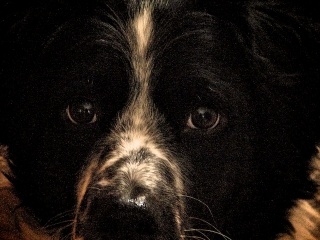On the Use of Food

I'm still disappointed over missing the APDT conference. Last minute crises are what they are, but I am still disappointed. It would have been my first conference and it was also as close as the conference will ever get to me. <sarcasm>We have a very small number of trainers here in the NYC area and the northeastern United States, so there is no reason to hold a conference over here.</sarcasm> Ironically enough, it was even close enough for me to visit family…instead I spent the week over there, dealing with unhappy family things.
Some of this disappointment has been mitigated recently by the excellent recordings of the conference presentations offered here. I have been listening to them on and off for weeks, and had 12 hours of driving to do this weekend to and from a Nose Work Seminar in Maryland. (I had to go for a day, come home, and then go back. Long story.)
The combination of Nose Work and the excellent talks by John Rogerson and Ian Dunbar got me thinking about food in dog training. Mr. Rogerson (Who I really wanted to meet. He even comes from an engineering background like I do!) flat out says in his Dog Vinci Code talk that we use more food here in the U.S. than anywhere else in the world. Dr. Dunbar, as usual, stressed the importance of getting the food out of sight in the same session that you introduce a new behavior. His talk title evens ends with "without the Continued Use of Food."
In Nose Work, you use food (or not, with some dogs you can use a toy) to get the dog interested in boxes, then you move to other objects, and then you will likely move to "odor" and the food takes a backseat to the task at hand. And really, you're letting your dog know that it's OK to do something that she already really wants to do, just in a certain context. The last thing you need to do if you want her to leave your side and go sniff somewhere else is make her think you have food in your hand or pocket.
During the first night of my obedience classes I explain why we use food: it's the greatest common denominator of rewards for any random sampling of pet dogs. Sure, there are dogs that are more motivated by play, balls, or affection, but food will usually work unless something else like fear is taking over. Food is merely a tool. I explain that the food is for acquiring new behaviors only, and should only be visible at the very first stage, for behaviors that require luring. I start talking about using play as a reward in that first session too. For the very next week, play is in use as a reward and people with food in their hands are coached otherwise.
These thoughts were swelling around in my head as I arrived home late from the Nose Work weekend in Maryland. I was sitting at the dining room table when my wife called Buddha for his eye medication. Somehow (I'm thinking during his "Kung Fu" matches with Caffeine) one of his eyes was scratched. (They use a lot of paws.)
When I had left Friday night she needed help giving him the drops and applying the cream to his eye. (Yeah, I know. Ew.) He is a very biddable and agreeable guy about stuff like this, but getting the cream onto the eye was difficult and much easier with two people to manage the eye and the cream.
"Don't you need help?" I asked as I looked up from my very late dinner.
"No, he's feeling a lot better now and just lets me do it."
A minute or so later I noticed she was still kneeling by him and scratching his ears. "Are you sure you don't need help?"
"We're done. He was a very good boy and this is his favorite reward."
Really, what more can I say?




